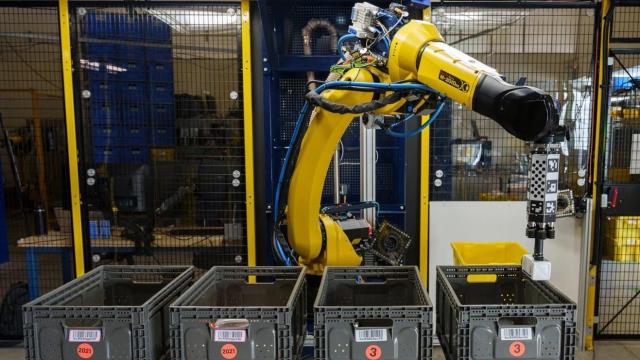Amazon’s adding a new AI infused package grabbing robot to its growing army of soulless, metal warehouse workers.
This week, at Amazon’s Delivering The Future conference near Boston, the company unveiled Sparrow, an AI assisted robotic arm its creators say uses computer vision to identify and move “millions” of objects. Sparrow, CNBC notes, will work in Amazon warehouses, where it will move products before they are packaged, work previously done primarily by overworked, and constantly surveilled human Amazon workers. In a press release, Amazon said Sparrow is, “the first robotic system in our warehouses that can detect, select, and handle individual products in our inventory.”
Amazon doesn’t want people to think too hard about the nontrivial amount of workers who might find themselves out of a job because of Sparrow. Amazon said Sparrow will primarily engage in “repetitive tasks” which should, in theory, let workers spend their time focusing on other, potentially more enriching tasks and cut down on workplace injuries. In their press release, Amazon claimed the design and deployment of its robotics tech over the years has actually led to the creation of 700 job categories within the company. Additionally, Amazon said it offers employees a 12-week classroom apprenticeship program called Amazon Mechatronic and Robotics Apprenticeship, where workers can train to develop new skills in robot maintenance and other areas. Though a nice thought, retraining programs, both in the private and public sector, are far from perfect.
“Robotics technology enables us to work smarter, not harder, to operate efficiently and safely,” Amazon said.
Anything Amazon can do — new robotics initiative included, to reduce risks of injuries at its warehouses — would represent a win for Amazon. A study of Amazon safety data released last year by the Strategic Organising Centre concluded injuries at Amazon warehouses were a staggering 80% higher than the rest of the industry. That stark disparity, according to the study, was driven primarily by Amazon’s notoriously ruthless commitment to speed and efficiency. In some cases, that rabid quest for maximum output apparently forced some workers to resort to peeing in water bottles to avoid being docked for taking bathroom breaks.
Simply adding more efficient robots to the mix, however, isn’t a guaranteed solution. In fact, there’s evidence to suggest those robots could make the situation even worse. An investigation conducted in 2020 by Reveal for The Centre For Investigative Reporting found higher rates of workplace injuries at facilities with more robots. While that may seem counterintuitive, the report claims the added layers of efficiency ushered in by the robots led to increased productivity quotas for workers at the facility. Rather than pick up the slack, the robots reportedly incentivized Amazon to push its workforce even harder, in some cases to workers’ physical breaking points.
“If you’ve got robots that are moving product faster and workers have to then lift or move those products faster, there’ll be increased injuries,” Occupational Safety and Health Administration medical officer Kathleen Fagan said in an interview with Reveal.
